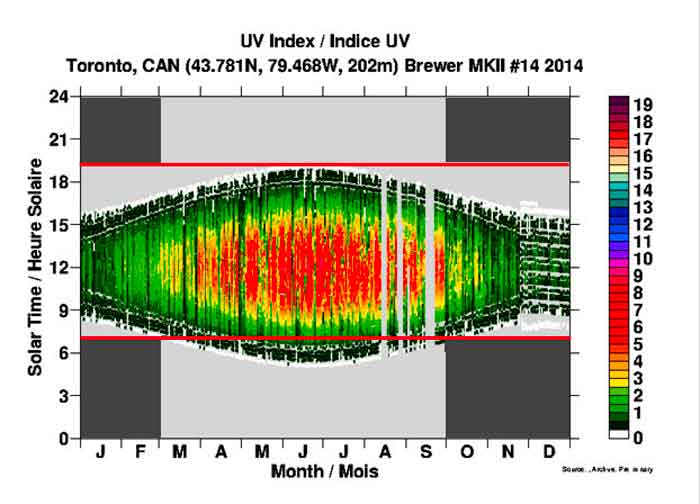The prior post suggested that any mechanism which serves to diminish, or mitigate, the effects of mechanical insult to the brain will have profound benefit for the injury victim. Further, it was proposed that a deficiency in UV light exposure may impair the ability of the pineal gland to synthesize the required sulphate, and that it is this UV deficiency which serves to explain the increased severity of brain trauma expressed as PCS.
This post seeks to examine these two theses through a review of the subject’s UV exposure in the days and weeks prior to the March 6th, 2011 accident that resulted in his mTBI injury.
Figure 4 below presents a graph of annual UV index values as measured by a Brewer spectrophotometer located at an Environment Canada monitoring station in Toronto, Canada (43.781N, 79.468W, 202 m.). This is the station with a published Internet record located nearest to the subject’s residence at 45.25N, 75.41W, elevation 70 m. Latitude and elevation both affect UV exposure levels with an increased UV exposure occurring at higher elevations, and a decreased exposure being experienced at higher North latitudes during the winter season. A further consideration is the degree of insolation at the two sites. Insolation data has not been collected, but it is believed that the 45.25N site would show a greater degree of cloud cover and reduced insolation over the course of a year and that the UV index presented in Figure 4 for the 43.781N station location likely overstates the UV index in the area of the subject’s residence.

Figure 4 – Annual UV Index for 43.781N, 79.468W, 202 m
The graph has been modified by the placement of horizontal red lines which serve to indicate the approximate time of the subject’s departure for work at 1930 hours and his return home from work at 0700 hours. The gray blocks in each of the four corner quadrants represent the time the subject would be at work in a brightly illuminated open office. These gray blocks have not been fully extended across the width of the graph so as to avoid obscuring the reported UV index spectrophotometer data.
What is immediately apparent from this graph is that in the period immediately prior the the March 6th accident date, the subject had essentially zero exposure to UV light. In fact, over the course of the full calendar year, his work and sleep schedule would preclude his obtaining significant UV exposure.
If it is correct that UV exposure is required to permit the pineal gland to catalyse sulphate into “structured water” with a neuro-protective benefit, it is evident that the subject is unlikely to have experienced such a benefit. The absence, or reduced availability, of “structured water” therefore increases the brain’s vulnerability to acceleration / deceleration forces and the associated sheer stress which is recognized as a key factor in DAI injury. In view of this it is highly likely, ceteris paribus, mutatis mutandis, that the diminished UV exposure of the subject formed a significant contributing factor to the severity of the mTBI injury suffered on March 6th, 2011.
—————————————
Note
The header image displays the illumination found on January 3rd, 2016 at 1320 hours.
Posts in the PCS Sequence
PCS Thesis – Index
PCS Thesis – The Accident
PCS Thesis – Injury Modalities
PCS Thesis – The Pineal Gland
